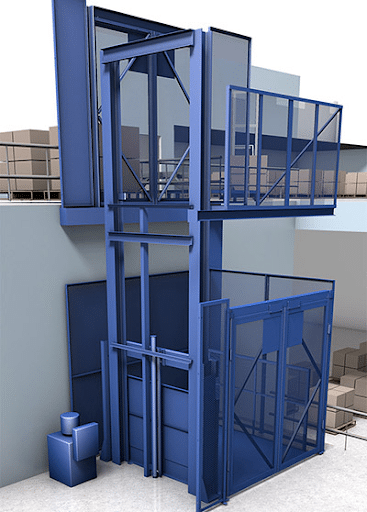
Even better, they make civilized life in big cities possible. However, there is a similar device of equal importance to upward transportation needs—the vertical reciprocating conveyor (VRC).
Let’s look at what VRCs are, how they differ from elevators, and why they are not classified as elevators.
What Is a Vertical Reciprocating Conveyor?
A VRC is a safe, cost-effective, and easy way to move material loads from one floor level of a structure to another. They’re used in many industries, are ideal for multi-level facilities, and transport only materials.
VRCs are used in a wide variety of material handling applications including, and are ideal for:
- Use in warehouses, third-party logistics (3PLs), industrial complexes, retail stores, manufacturing facilities, libraries – anywhere materials need to be lifted, indoors or outdoors
- The vertical lifting of materials between the ground, mezzanine, basement, balcony, upper level, or rack storage systems
- Installation in an existing elevator shaft, through a floor, next to a balcony or mezzanine, indoors or outdoors
- Providing an efficient, safe, and cost-effective way to vertically transport materials
- Safely lifting materials of any shape, size, or weight to one or multiple floor levels
Industries That Use VRCs
Vertical reciprocating conveyors (VRCs) allow businesses to utilize their existing building space to safely and efficiently move materials between levels. PFlow has engineered material lifting solutions for industries including but not limited to:
Here are a few businesses who have found great success by installing a PFlow VRC:
PFlow Champions Adoption of Conveyor Code
For many years, VRCs were required to meet the same stringent safety codes as people-moving elevators. Stricter VRC regulations gave elevator manufacturers a competitive edge over vertical conveyor manufacturers. In short, elevator manufacturers had a vested financial interest in adding regulations to VRCs because it reduced competition and added unneeded cost to the manufacture, installation and operation of VRCs.
Although VRCs have many built in safety features, PFlow Industries was instrumental in establishing state and federal codes that apply specifically to material-only lifts, exempting VRCs from many of the stringent, redundant safety requirements required for people-moving elevators.
Because of the differences between passenger elevators and VRCs, PFlow founder, Bob Pfleger and his business partner, Herb Ruehl, appealed to ASME (American Society of Mechanical Engineers) and ANSI (American National Standards Institute), asking that VRCs have a different code standard than elevators. They argued that because VRCs do not move people, they do not require the costly redundant safety features that protect people from injury or death while riding inside an elevator. In March 1981, ASME ruled in favor of PFlow by judging that material only lifts are covered under ANSI/ASME code B20.1 and, therefore not under the jurisdiction of the elevator industry and ASME A17 elevator code requirements.
